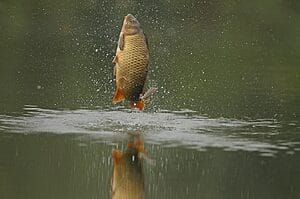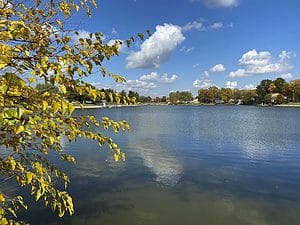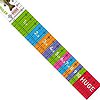Disclosure: Some posts contain affiliate links, which earn us a commission if you make a purchase through them. Positive Fishing © participates in various affiliate networks including the Amazon Services LLC Associates Program.
Carp fishing on the fly has become popular over the last few years, and for a good reason. Carp are a highly accessible species worldwide; they are big, pull line, and can be very tricky to catch, all things that we fly fishermen love in an intended target.
But how do you be successful? What are the tactics? What flies work? That is what we are here to find out.
Join me as I run through everything you need about fly fishing for carp so you can go out and succeed.
What Carp Can You Catch With A Fly Rod?
There are quite a few different species of carp you can convince to eat and fly, including grass, common, and even mirror carp. Basically, all types of carp can be caught on a fly.
Grass carp feed mainly on vegetation, hence the name, and grow up to 60 inches in length and reach up to 100 lbs. Common carp can also reach the 100 lb mark but stay short and grow in width instead, only reaching about 40 inches.
Mirror carp will also hit the 100lb mark, and the largest mirror you’re likely to find on a fly will be about 20-30 lbs, but larger ones are out there.
Can you imagine being hooked to a 100 lb freshwater submarine on a fly rod? This is why this style of fly fishing has become so popular in recent years.
If you are new to the art of fly fishing, you can learn more about fly fishing basics in my detailed article on how to start fly fishing, gear, tips, and set-up!
Targeting Carp On The Fly?
You will find carp in lakes, rivers, or ponds where the water is warm enough for them to be comfortable. This means the lower reaches of US rivers like the South Platte in Colorado, lakes such as Lake Michigan, or the many carp rivers and lakes of the UK, France, and Spain.
You can read more specifically about catching carp in the US to learn about joining this fast-growing sport in the states.
The key to finding good carp fly water is to pick a place where you can see the carp, as they have to be sight-fished in most cases for you to be successful. This means finding shallow flats and clear waters where you can see the carp easily.
What Time Of Year Is Best For Fly Carp Fishing?
The best time of year for catching carp with a fly rod is during the late spring, summer, and early autumn. However, when the water temperature gets too cold or too hot, the carp will head to the deeper areas to find a more comfortable temperature for them to feed.
Therefore, you want to avoid the times of the year with extreme temperatures and stick mainly to spring and fall, depending on your climate. This is when you’ll see them on the shallow flats and feeding closer to the surface.
Carp fly fishing in the winter is not as easy and can result in disappointing results. In winter, you will need to keep the fly much further away from the carp and keep it still. If you are lucky, the carp may get curious and take the fly. Any movement of the fly in the water is likely to spook it and swim away.
Understanding Carp Behaviour

their swim bladder to adjust its level in the water
Carp are intelligent fish; once you have found a good spot to fish for them with a fly rod, it’s time to understand their behaviours.
Not all carp will be willing to eat a fly; it depends on how they act. Some factors almost guarantee a take on your fly, and some will guarantee failure. Let’s run through them now.
Splashing Carp
If you see carp splashing on the surface, they are not eating dry flies; the carp are actually spawning and thus have no interest in feeding. If you see carp doing this, do not waste time casting a fly at them.
Fast Moving Carp
If you see a group of carp or a single carp moving quickly across a shallow flat or close to the surface, they are trying to get somewhere fast and therefore are not in the mood to eat. Don’t bother casting a fly to carp behaving this, either.
Sunbathing Carp
Sometimes carp will bask in the sun near the surface, and these carp are definitely worth casting a fly to. Eight times out of ten, a basking carp will spook and swim away, but if your presentation is immaculate and subtle, they might eat the fly as it’s falling past them.
Slow Moving Carp
A single carp or a group of carp slowly swimming across a shallow-water flat deserves an excellent cast. These carp are patrolling, looking carefully for a good place to feed, and therefore might take a well-presented fly, but it’s no better than a 50/50 chance they will eat it.
Tailing Carp
When carp are tailing, their heads will be in the mud, with their tails sticking out of the water. These carp are actively feeding, which is when you must make a cast towards them, and your chances of a hook-up are excellent.
Try fly patterns resembling leeches, crayfish, or small fish.
Rising Carp
Occasionally carp will sip insects or even berries off the surface the same way a trout would. This is a great time to catch a carp on a dry fly, but you must match the hatch exactly right. Ensure you choose a dry fly which is hatching; otherwise, the fish will be suspicious and refuse to take the fly.
Tactics For Carp Fishing On The Fly
Carp are smart fish and rather spooky, too, so you’ll need to land your casts and flies delicately so as not to scare them off. It’s just like casting to a school of bonefish; presentation, accuracy, and delicate drops are key to success.
Cast Close To The Fish
While carp are clever, they don’t have particularly good eyesight, so they will not see your fly 10 feet away and come and eat it. You need to land your fly within 3 feet of the fish for them to see it and without spooking them.
If the carp are moving, I recommend casting 6 feet ahead and wait for the fish to swim close to the fly. This way, you can avoid the spook and get the fly exactly where it needs to be. Make sure that you mend correctly and slowly without too much disturbance to the water’s surface.
Drag & Drop Method
The drag and drop method is a great way to target carp as it allows you to cast ahead of the fish, so they don’t spook. Once your fly has landed, strip it slowly until it’s close to the fish and let the fly sink. Usually, as the fly sinks is when the carp will eat.
Static Dry Flies
If you see rising carp, matching the hatch and throwing a dry fly onto the surface is a great way to hook up. Be sure to cast your fly near a feeding fish and then strip incredibly slowly, so the fly seems static, but you are always in contact with it.
Mulberry Plopping

If you can find some good carp water with mulberry trees around it, you could have some of the best opportunities for catching carp. When the mulberries drop into the lake, the carp hear this and sip them off the surface.
The best tactic here is to use a mulberry fly pattern and create the exact same plop to attract a carp to sip your fly off the surface.
The Dog Biscuit Cheat
Any purist fly fisherman reading this will be disappointed with this tactic, but it’s a ton of fun if you want to catch ten or more carp in an hour or two at your local lake.
You’ll need a bag of dog biscuits and some dog biscuit flies made from spun deer hair. The idea is to go to the lake, throw out some dog biscuits, and wait for the carp to start eating them off the surface.
Afterwards, throw your dog biscuit fly in there and wait for a carp to sip it off the surface. It’s a fun way to catch fish without going into full carp mode.
Floating dog biscuits are also an extremely popular bait for carp anglers to use when freelining.
Bread Flies
Bread flies for carp are similar to the dog biscuit fly imitation. You can use thick deer hair for the best-floating fly. White or brown hair will represent the bread colour best.
Fly Fishing For Carp In Rivers
If you are river fly fishing, then you can approach carp just like you would trout. Carp also eat nymphs, and dry flies, so find some water with a good current and drift your flies just like you would for trout.
You’ll probably catch a range of species outside carp, as everything in the river will eat nymphs.
Setting The Hook
A tricky part of hooking carp with a fly is getting the hook set right; timing is key. If a carp takes your fly off the surface, a quick rod lift is best to hook up with but strike too early or too late, and you will miss the fish. Practice is the only way to get the timing right.
If you are fishing subsurface for carp, the eat can be very subtle, especially if they inhale your fly on the drop. You have to keep in contact with your fly as much as possible, and when you feel any tension, a short strip set is best.
If you feel contact but don’t hook up, let the fly drop again as they often come back to have another go at it.
What Flies Are Best For Carp?
)
As with every form of fly fishing, it is best to match the hatch with carp too. Since carp feed mainly off the bottom, you are going to want a range of flies that imitate:
- Nymphs
- Crayfish
- Worms
It’s also very important to have these imitations in a range of different weights so you can get them to the depth the carp are feeding.
For dry fly carp fishing, it’s again about matching the hatch and some great flies to use for fly carp fishing are:
- Mayflies
- Ants
- Hoppers
- Beetles
- Mulberries
- Dog Biscuit
I recommend starting with the three best carp flies and building your collection from there.
There are a lot of carp flies to choose from. Carp fly patterns typically resemble crayfish (a favourite food for carp), leeches, aquatic nymph stages of dragonflies or damselflies, and other small fish.
These flies should act as if they are alive, and a carp will forage for the current food source around during that time of the year. However, like trout fly fishing, anglers still have to decide what may or may not work.
Mop Fly Pattern
)
The Mop fly has been one of my favourite fly patterns for carp for many years. When dragging near the bottom, the mop flies always seem to catch when other flies don’t work. I usually start with a size 8 in various colours, but the orange or light brown seems to entice the carp to eat the fly.
Using a mop fly pattern will also result in a good chance of catching trout if the carp seem not too interested,
Carping Out
Thanks very much for reading my article. I hope you enjoyed it and it has inspired you to go carp fishing using flies. It really is a great form of fly fishing, especially when stalking carp in the shallows and sight casting.
You can read more about other carp-related fishing tactics, such as my guide to boilie fishing for carp, and another awesome tactic about how to fish the margins for carp.
- 5 Best Fishing Bags For Getting Your Gear Organized - January 13, 2025
- 4 Essential Surf Fishing Rigs - January 11, 2025
- How To Know The Sex Of A Fish You Have Caught? - December 9, 2024

